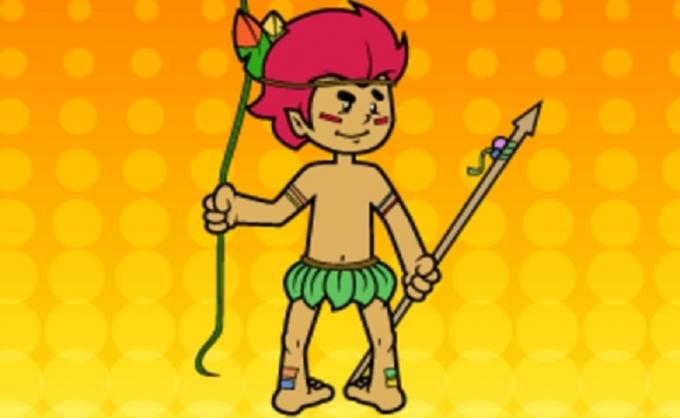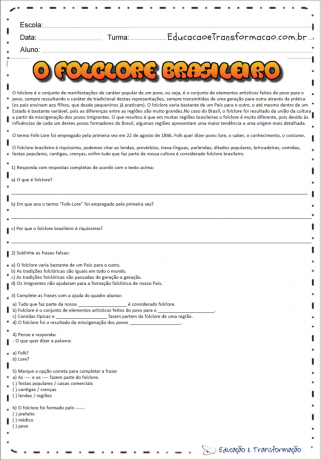
We selected in this post several Folklore Text Interpretation Activities, ready to print and work with early graders in the classroom or as a homework assignment.
O Folklore DayBrazilian is celebrated in August 22. The date was created in order to raise awareness of the importance and appreciation of folkloric manifestations in the country.
Remember that folklore is the set of knowledge, customs, beliefs, parlendas, tales, myths, legends, riddles, songs, dances and popular festivals of a culture and region.
We also recommend: Folklore activities.
Index

Legend has it that Saci-Pererê is a little black man, short, with one leg, wearing a red cap on his head and a pipe in his mouth.
Saci-Pererê enters the houses of the residents, puts sugar in the food, puts out the fire, tickles the chickens, irritates the dogs, lets the horses go, scares the travelers and many other nonsense.
They say that travelers, in order to get rid of the naughty, carry tobacco and cachaça to give them as gifts and hope that they will go away.
The boys who were the children of the slaves with the masters, were abandoned in the woods, died pagans, and because of that, they became Sacis.
Answer:


The legend of the urutau:



There are many versions of the headless mule. One of them tells that a woman fell in love with a priest.
This woman has turned into a headless mule, who on Thursday to Friday nights appears neighing, to frighten everyone she meets.
Despite its name, the mule does have a head, it's just that she releases so much fire through her nose and mouth that she can't see this part of her body.
If someone is brave enough to pull the iron bit off her, or poke her with a pin to make her bleed, she can break the spell.
The mule takes the shape of a woman and cries a lot.
Answer:

Deep in the woods, far from towns and villages, when long and shrill screams sound, it is Curupira who approaches.
The best thing to do is get out of there running.
Curupira is a dwarf with red hair, green teeth and feet turned backwards. To the Indians he is the devil of the forest. He runs after them, enraged, to beat and even kill. To protect themselves, when they move away from their villages, the Indians leave bird feathers, shakers and arrows along the way.
Curupira is the protector of trees and animals. Beating the trunks of trees like drums, he tests their stamina when a storm threatens.
He hates men who hunt and destroy the woods. That's why he likes to let hunters stray into the forest. Whoever sees Curupira completely loses his way, he no longer knows how to find his way back…
To attract its victims, Curupira sometimes calls people with screams that mimic the human voice.
Curupira's stories are told throughout Brazil. In some regions, he is called Caipora or Caapora, and is often seen mounted on a wild boar.
1- How is Curupira?
2 – What does Curupira do with hunters?
3 – What does Curupira do to attract its victims?
4 – What other names does Curupira have in other regions of Brazil?
5 – Check only the correct alternative:
a) In the forest, what signs announce that the curupira is coming?
( ) Long, shrill screams.
( ) Trees destroyed on the way.
( ) Wild pig tracks.
( ) Storm sounds.
b) Curupira tests the resistance of trees to
( ) protect them from the Indians.
( ) know if they will not fall with heavy rain.
( ) attract its human victims.
( ) scare the destroyers of the forest.
c) The story of Curupira is about a
( ) demon that scares forest animals.
( ) Indian who uses shakers and arrows.
( ) man who gets lost in the forest and is terrified.
( ) dwarf that protects trees and animals.
d) Curupira lives in
( ) villages. ( ) cities.
( ) woods. ( ) trunks.
e) People are afraid because Curupira
( ) chases whoever destroys nature.
( ) plays drums hidden at night.
( ) protects trees from storms.
( ) attacks wild and dangerous animals in the forest.
f) In the text, the word enraged means
( ) in a hurry. ( ) furious.
( ) clumsy. ( ) noisy.
Also check out some Brazilian folklore legends to print

Brazilian Folklore
Folklore is the set of manifestations of a popular character of a people, that is, it is the set of artistic elements made by the people for the people, always emphasizing the traditional character of these representations, always transmitted from one generation to another through practice (parents teach their children, who have already been little practice). Folklore varies a lot from one country to another, and even within a State it is quite variable, as the differences between regions are very large. In the case of Brazil, folklore was the result of the union of culture from the miscegenation of immigrant peoples. What resulted is that in many Brazilian regions the folklore is very different, because due to the influences of each of these peoples who formed Brazil, some regions have a greater tendency towards a more detailed.
The term Folk-Lore was first used on August 22, 1846. Folk means people; lore, knowledge, knowledge, custom.
Brazilian folklore is very rich, we can cite legends, proverbs, tongue twisters, parlendas, popular sayings, games, food, popular festivals, songs, beliefs, everything that is part of our culture is considered folklore Brazilian.
1) Respond with complete answers according to the text above:
a) What is folklore?
b) In what year was the term “Folk-Lore” first used?
c) Why is Brazilian folklore very rich?
2) Underline the false sentences:
a) Folklore varies greatly from one country to another.
b) Folk traditions are the same all over the world.
c) Folk traditions are passed down from generation to generation.
d) Immigrants did not help in the formation of folklore in our country.
3) Complete the sentences with the help of the table below:
a) Everything that is part of our ___________________ is considered folklore.
b) Folklore is the set of artistic elements made by the people for the ______________________.
c) Typical foods and ____________________ are part of the folklore of a region.
d) Folklore was the result of the miscegenation of the ____________________ peoples.
4) Think and answer:
a) Folk?
b) Lore?
5) Check the correct option to complete the sentence:
a) The —- and the —- are part of folklore.
( ) popular parties / commercial houses
( ) songs / beliefs
( ) legends / regions
b) Folklore was formed by —–.
( ) Mayor
( ) doctor
( ) people
Subscribe to our email list and receive interesting information and updates in your email inbox
Thanks for signing up.
